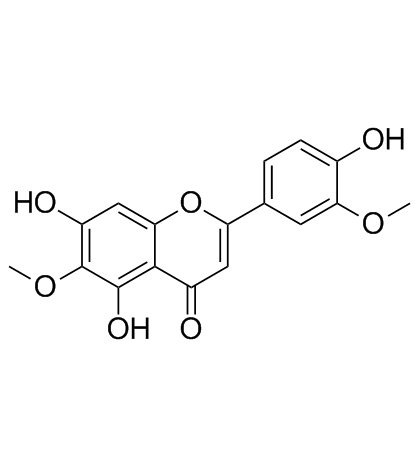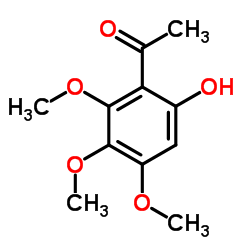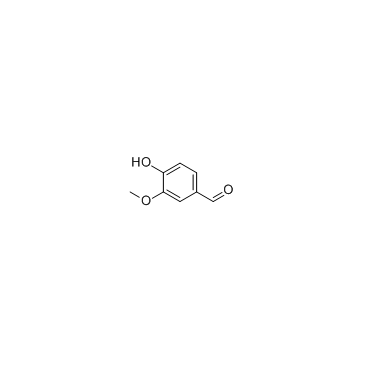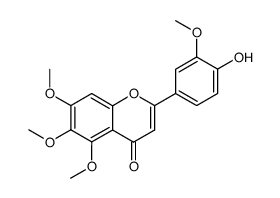18085-97-7
| Name | jaceosidin |
|---|---|
| Synonyms |
5,7,4'-trihydroxy-3',6-dimethoxyflavone
4H-1-Benzopyran-4-one, 5,7-dihydroxy-2-(4-hydroxy-3-methoxyphenyl)-6-methoxy- 5,7-dihydroxy-2-(4-hydroxy-3-methoxyphenyl)-6-methoxychromen-4-one 5,7-Dihydroxy-2-(4-hydroxy-3-methoxyphenyl)-6-methoxy-4H-chromen-4-one 5,7,4'-trihydroxy-6,3'-dimethoxyflavone JACEOSIDINE 4',5,7-Trihydroxy-3',6-dimethoxyflavone 6-methoxyluteolin-3'-methyl ether Jaceosidin |
| Description | Jaceosidin is a flavonoid isolated from Artemisia vestita, induces apoptosis in cancer cells, activates Bax and down-regulates Mcl-1 and c-FLIP expression[1]. Jaceosidin exhibits anti-cancer[2], anti-inflammatory activities, decreases leves of inflammatory markers, and suppresses COX-2 expression and NF-κB activation[3]. |
|---|---|
| Related Catalog | |
| Target |
Bax COX-2 |
| In Vitro | Jaceosidin (30, 50, 75 μM) induces apoptosis in human renal carcinoma Caki cells after treatment for 24 h, shows no obvious effect on normal cells[1]. Jaceosidin (75 μM) reduces MMP levels and causes cytochrome c release into the cytoplasm through Bax activation[1]. Jaceosidin-mediated apoptosis is involved in downregulation of Mcl-1, c-FLIP expression, which is via inhibition of NF-κB and/or Sp1 transcriptional activity[1]. Jaceosidin shows cytostatic activity to HES and HESC cells with IC50s of 52.68 and 55.10 μM, and is less cytotocxic on Hec1 A and KLE (IC50, 70.54, 147.14 μM, respectively), after treatment for 48 h[2]. Cell Viability Assay[2] Cell Line: Hec1A, KLE, HES and HESC cells Concentration: 3.125, 6.25, 12.5, 25, 50, and 100 μM Incubation Time: 48 hour Result: Showed cytostatic activity to HES and HESC cells with IC50s of 52.68 and 55.10 μM, less cytotocxic on Hec1 A and KLE (IC50, 70.54, 147.14 μM). |
| In Vivo | Jaceosidin (10 and 20 mg/kg, p.o., once a day for 3 days) blocks carrageenan-induced increase in leukocyte number and protein levels in air pouch exudates in mice[3]. Jaceosidin (10, 20 mg/kg, p.o.) suppresses COX-2 expression and NF-κB activation in mice[3]. Jaceosidin (20 mg/kg, p.o. for 2 hours) reduces hind paw edema volume in rats[3]. Animal Model: 5-week-old male BALB/c mice (23-26 g)[3] Dosage: 10 and 20 mg/kg Administration: P.O. once a day for 3 days Result: Decreased the volumes of exudates (inflammatory markers), cell number and protein levels. Inhibited TNF-α by 46.7% and 50.8%, IL-1β by 46.0% and 44.7%, and PGE2 by 21.7% and 16.9%, respectively, at 20 mg/kg. Blocked COX-2 expression and NF-κB activation. Animal Model: Male Sprague-Dawley rats (180-200 g)[3] Dosage: 20 mg/kg Administration: P.O., for 2 hour Result: Reduced hind paw edema volume by 27.1% at 1 h, and 24.0% at 2 h, respectively. |
| References |
| Density | 1.5±0.1 g/cm3 |
|---|---|
| Boiling Point | 619.0±55.0 °C at 760 mmHg |
| Molecular Formula | C17H14O7 |
| Molecular Weight | 330.29 |
| Flash Point | 232.0±25.0 °C |
| Exact Mass | 330.073944 |
| PSA | 109.36000 |
| LogP | 1.30 |
| Vapour Pressure | 0.0±1.9 mmHg at 25°C |
| Index of Refraction | 1.671 |
| Storage condition | 2-8℃ |
| HS Code | 2914509090 |
|---|
|
~% 
18085-97-7 |
| Literature: Bioorganic and Medicinal Chemistry Letters, , vol. 22, # 7 p. 2534 - 2535 |
|
~% 
18085-97-7 |
| Literature: Bioorganic and Medicinal Chemistry Letters, , vol. 22, # 7 p. 2534 - 2535 |
|
~% 
18085-97-7 |
| Literature: Bioorganic and Medicinal Chemistry Letters, , vol. 22, # 7 p. 2534 - 2535 |
|
~% 
18085-97-7 |
| Literature: Bioorganic and Medicinal Chemistry Letters, , vol. 22, # 7 p. 2534 - 2535 |
| Precursor 3 | |
|---|---|
| DownStream 1 | |
| HS Code | 2914509090 |
|---|---|
| Summary | HS:2914509090 other ketones with other oxygen function VAT:17.0% Tax rebate rate:9.0% Supervision conditions:none MFN tariff:5.5% General tariff:30.0% |





